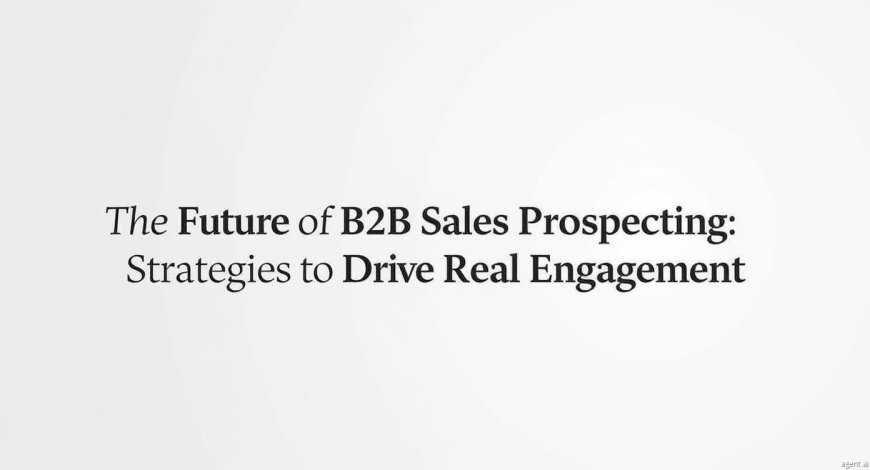The Future of B2B Sales Prospecting: Strategies That Drive Real Engagement
B2B sales prospecting has transformed into a sophisticated and insight-driven discipline. What once relied heavily on cold calls and door-to-door visits now leans into behavioral data, personalization, and advanced outreach strategies.

Businesses that embrace this evolution are seeing greater engagement, higher conversion rates, and stronger relationships with their target accounts.
The future of B2B Sales Prospecting is not just about volume it's about precision. With buyers expecting tailored experiences and proactive value from vendors, companies must reimagine how they discover, qualify, and connect with leads. The sales funnel starts with prospecting, and when this first step is executed effectively, every stage that follows benefits.
Understanding Buyer Behavior in the Modern Prospecting Era
Buyers today conduct 6070% of their research before ever speaking to a sales rep. They consume whitepapers, visit comparison sites, watch webinars, and read reviews to shape their opinions. This shift in buyer behavior has redefined B2B sales prospecting.
To succeed, prospecting efforts must align with how and when buyers seek information. That means engaging them when theyre actively exploring solutions, addressing their specific needs, and offering insights that accelerate decision-making. When sales teams understand buyer intent and align messaging with real-time behavior, they become true partners rather than mere vendors.
Intent-based B2B sales prospecting leverages data from content consumption, website visits, and keyword activity to pinpoint prospects showing buying signals. These signals form the foundation for highly targeted outreach strategies.
Account-Based Sales Prospecting in Action
Traditional prospecting often involved casting a wide net. In contrast, account-based prospecting focuses on a defined list of high-value targets. Instead of reaching out to anyone who might be a fit, sales teams zero in on companies that represent ideal client profiles.
Account-based B2B sales prospecting includes:
-
Identifying high-potential accounts based on firmographics, technographics, and intent signals
-
Mapping out key stakeholders and decision-makers within each account
-
Crafting custom outreach strategies tailored to each role and need
This approach demands more upfront effort but pays off with higher engagement, deeper relationships, and better win rates. In an era of personalized buying experiences, account-based prospecting ensures relevance at every touchpoint.
Crafting Messaging That Converts
In B2B sales prospecting, the quality of your message can determine whether a lead engages or ignores your outreach. Reps must go beyond generic scripts and deliver messages that are tailored, contextual, and credible.
Effective prospecting messages should:
-
Acknowledge the prospects current challenges
-
Reference specific events, trends, or data points related to their business
-
Position your product or service as a solution to those challenges
-
Include a simple and clear call to action
Using personalization at scaleby leveraging CRM data, LinkedIn insights, and automation toolsallows sales reps to send relevant messages without compromising efficiency. The more your outreach speaks directly to a prospects business context, the more likely they are to respond.
Using Video to Stand Out in Outreach
Video is an underutilized but powerful tool in B2B sales prospecting. In a crowded inbox, a 60-second personalized video can increase open and reply rates significantly. Tools like Vidyard and Loom allow sales professionals to record quick introductions, walkthroughs, or screen recordings that add a human element to digital communication.
Why video works:
-
It builds trust faster than text
-
It shows effort and attention to detail
-
It demonstrates the personality and tone behind the message
Sales reps using video in prospecting stand out and often receive feedbackeven when the lead isnt ready to buy. It opens the door for future engagement and positions your brand as innovative and approachable.
Cold Calling: Reinvented for Relevance
Despite the rise of digital channels, cold calling is not deadit just needs reinvention. Successful cold calls today are not random interruptions; they are timely, informed, and concise conversations based on data.
Modern cold calling in B2B sales prospecting includes:
-
Researching the contact and their company before dialing
-
Opening the call with context (e.g., recent news, shared connection)
-
Offering value early (e.g., insight, observation, or recommendation)
-
Asking smart discovery questions to qualify interest
Reps who practice active listening and tailor their calls to the individuals needs build rapport faster. Cold calling becomes a welcome interaction rather than a disruptive one when executed with preparation and professionalism.
Enhancing Response Rates with Follow-Up Sequences
One of the biggest mistakes in B2B sales prospecting is stopping after one or two outreach attempts. The reality is that most leads require at least six to eight touches before engaging. Follow-up sequences help maintain consistent visibility without overwhelming the prospect.
A strategic follow-up cadence might include:
-
Day 1: Initial email + LinkedIn connection request
-
Day 3: Call attempt + LinkedIn message
-
Day 5: Follow-up email with a case study or relevant article
-
Day 7: Second call or voicemail with personalized insight
-
Day 10: Final email summarizing the value proposition
Each touchpoint should offer a new angle or piece of value. Repetition alone wont drive responsesresonance will. Consistency, relevance, and timing are what turn silence into conversations.
Prioritizing Leads with a Scoring Model
Lead scoring is a valuable technique to streamline B2B sales prospecting. It helps reps focus on leads with the highest probability of converting by assigning scores based on behavior, fit, and engagement.
A basic lead scoring model may consider:
-
Role/title match with decision-making authority
-
Company size, revenue, and industry alignment
-
Website behavior (e.g., pricing page visits, demo requests)
-
Email engagement (opens, clicks, replies)
When lead scores are updated in real-time, reps can act immediately on high-scoring prospects, ensuring timely outreach. This not only improves response rates but also shortens the sales cycle by engaging leads at peak interest.
Aligning Marketing and Sales for Seamless Prospecting
B2B sales prospecting becomes more powerful when marketing and sales collaborate. Marketing teams generate inbound leads, nurture long-term prospects, and develop content that informs and attracts. Sales teams use this content in outbound efforts to engage and educate.
Key points of alignment include:
-
Sharing insights on which content converts best
-
Using consistent messaging and brand voice
-
Creating shared dashboards for lead tracking and performance
-
Holding regular syncs to discuss feedback and optimize strategies
When marketing and sales are in sync, prospects receive a cohesive experience. Theyre more likely to trust your brand, respond to outreach, and move forward with confidence.
Overcoming Prospecting Fatigue with Automation
B2B sales prospecting can be repetitive and time-consuming. To avoid burnout and maintain performance, automation tools are essential. These platforms reduce manual work while preserving personalization.
Automation helps with:
-
Sending emails and scheduling follow-ups
-
Logging activities and notes in the CRM
-
Segmenting leads by behavior and scoring
-
Triggering outreach based on prospect actions
By automating low-value tasks, sales reps can dedicate more time to high-value conversations and strategic planning. This leads to better outcomes, greater job satisfaction, and improved pipeline performance.
Establishing Metrics for Prospecting Success
Without measurement, its impossible to know if your B2B sales prospecting efforts are working. Establishing clear metrics helps track performance, test new ideas, and refine strategies.
Important KPIs to track include:
-
Contact rate: How many prospects are you reaching?
-
Engagement rate: How many are opening, clicking, or replying?
-
Meeting set rate: How many convert to scheduled calls?
-
SQL rate: How many become sales-qualified leads?
-
Time to conversion: How long does it take to move from prospect to opportunity?
Reviewing these numbers regularly provides insight into whats effective. Teams can double down on top-performing tactics and rework those that fall short.
Creating a Winning Prospecting Culture
Prospecting is not just a processits a mindset. Teams that view B2B sales prospecting as a strategic and rewarding activity are more likely to succeed. Building a winning prospecting culture includes:
-
Recognizing and rewarding prospecting wins (meetings set, replies gained)
-
Holding regular prospecting power hours to build momentum
-
Sharing best-performing templates and techniques across the team
-
Encouraging healthy competition with leaderboards or gamification
Culture shapes behavior, and when prospecting is embraced as a core growth lever, it drives better results across the board.
Read the Full Blog Now @ https://acceligize.com/featured-blogs/what-is-b2b-sales-prospecting-and-how-to-engage-more-leads/
About Us
Acceligize is a global leader in B2B demand generation and sales enablement, specializing in connecting businesses with highly targeted, ready-to-engage prospects. Through innovative digital marketing strategies, buyer intent data, and multi-touch campaigns, Acceligize empowers sales and marketing teams to drive growth, generate qualified leads, and achieve faster revenue outcomes. With a focus on accuracy, engagement, and scalability, Acceligize delivers real, measurable results to enterprises across industries.






























